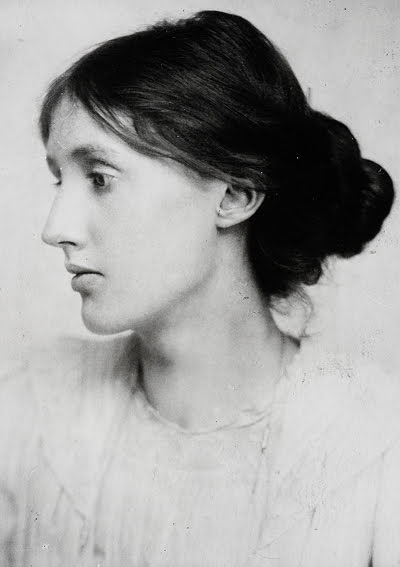Virginia Woolf

25 January: Born Adeline Virginia Stephen, third child of Leslie Stephen (Victorian man of letters, and first editor of the Dictionary of National Biography) and Julia Duckworth (of the Duckworth publishing family). VW has a comfortable upper middle class family background and upbringing. Her father had previously been married to the daughter of the novelist William Makepeace Thackery. Her brothers Thoby and Adrian went to Cambridge, and her sister Vanessa became a painter. VW was educated by private tutors and by extensive reading of literary classics in her father's library.
Death of her mother. VW has the first of many nervous breakdowns.
Death of her half-sister, Stella. VW studies Greek and History at King's College London.
Brother Thoby enters Trinity College, Cambridge and subsequently meets Lytton Strachey, Leonard Woolf, and Clive Bell. These Cambridge friends subsequently become known as The Bloomsbury Group. VW is an important and influential member of the group.
Death of her father. VW suffers her second serious breakdown. She moves to Gordon Square in Bloomsbury. Other residents of this Square include Lady Jane Strachey, Charlotte Mew, and Dora Carrington.
VW's first publication is an unsigned review in The Guardian.
Writes reviews and teaches once a week at Morley College, London, an evening institute for working men and women.
Death of her brother Thoby Stephen.
Marriage of sister Vanessa to Clive Bell. VW moves with her brother Adrian to live in Fitzroy Square.
She begins working on her first novel (which will become The Voyage Out).
Lytton Strachey, who is gay, proposes marriage to VW. She politely refuses.
She becomes involved with the women's suffrage movement.
Spends time in a nursing home in Twickenham.
VW moves to Brunswick Square, sharing a house with brother Adrian, Maynard Keynes, Duncan Grant, and Leonard Woolf.
Marries Leonard Woolf. Travels for honeymoon to Provence, Spain, and Italy. Moves to Clifford's Inn.
VW suffers another period of mental illness, and attempts suicide. After hospitalization, she is released to the care of her husband and nurses.
Leonard and VW purchase Hogarth House, in Richmond.
The Voyage Out is published and well received.
She goes through another bout of violent madness.
Lectures to Richmond branch of the Women's Co-Operative Guild. Writes regularly for the Times Literary Supplement, where her reviews are anonymous.
L and VW buy a hand printing machine and establish the Hogarth Press. Their first publication is Monday or Tuesday. Hogarth Press later goes on to publish T.S. Eliot, Sigmund Freud, and VW's own books.
Purchase of Monk's House, Rodmell.
Night and Day is published.
VW begins a brief friendship with Katherine Mansfield. Both are conscious of experimenting with the substance and the style of prose fiction.
Works on journalism and Jacob's Room.
The Mark on the Wall is published. VW is ill for most of the summer.
Jacob's Room is published. Her writing is encouraged by E.M. Forster, Strachey, and Leonard Woolf.
Meets Vita Sackville-West, with whom she has a brief love affair.
Works on "The Hours," which is an early version of Mrs Dalloway.
The Common Reader [essays] and Mrs Dalloway are published. The latter is a major break with the traditional novel, in both its form and techniques.
Unwell with German measles. Starts writing To the Lighthouse.
To the Lighthouse is published. She begins writing Orlando.
Orlando published — a fantasy dedicated to and based upon the life of Vita Sackville-West and her love of her ancestral home at Knole in Kent.
Delivers lectures at Cambridge on which she bases A Room of One's Own.
A Room of One's Own published — essays on women's exclusion from literary history. These essays subsequently have become of utmost importance in feminist studies.
First meets Ethel Smyth, a pipe-smoking feminist composer, who falls in love with VW.
Finishes her first version of The Waves.
The Waves is published. It is made up of the thoughts of six characters. The form takes VW's literary experimentation to its natural limits.
Death of Lytton Strachey. Begins writing "The Partigers," which is to become The Years.
Death of Roger Fry. Continues reshaping "The Partigers" into The Years.
Revises The Years.
Begins Three Guineas — a "sequel" to A Room of One's Own.
After six years of revising, The Years is published. VW says that it and Three Guineas should really be considered as one long work.
In many ways, The Years is an anomaly for VW. There's no central plot or protagonist, and there's very little of the poetic language that had become the hallmark of her style. It is flat throughout in both emotion and tone.
Three Guineas extends the feminist critique of patriarchy, militarism, and privilege started in A Room of One's Own.
Biography of Roger Fry published. Her London homes damaged or destroyed in blitz.
VW completes Between the Acts, her last novel.
Fearing the madness which she felt engulfing her again, she fills her pockets with stones and drowns herself in the River Ouse, near Monk's House.